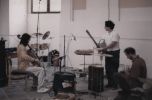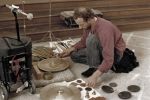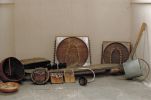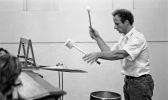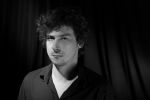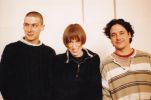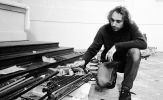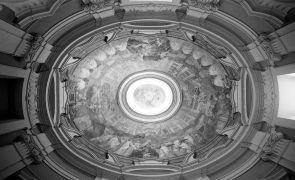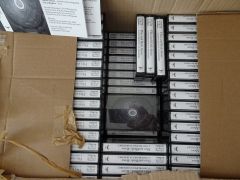"Flies and Birds Above" is the title of a new audio cassette created and published with support of the Agosto Foundation as part of a project archiving the activities of the Hermit Foundation and the Center for Metamedia in the Plasy Monastery. The material for the cassette was recorded during my residency at the Center during late summer of 1998, which also resulted in the designing and building of several musical instruments. In a way, this recording session was the culmination of a number of my meetings and collaborations at Plasy between 1992 and 1998. This edition features a new selection of fragments from approximately 10 hours of recording sessions that took place within the special acoustics of the space of Jan Blažej Santini Aichel’s baroque gem of the St. Benedict Chapel.
The material was recorded over five days by Jaroslav Kořán on a 4-track analog tape recorder. On side A, there are pieces which were originaly mastered into the demo CD Usuku by Milan Guštar in 2000. On side B, there are several heretofore unreleased segments selected and mastered by Jaroslav Kořán and Miloš Vojtěchovsky from the ten analog tapes which have survived to this day.
I first met Jaroslav Kořán in Plasy in 1992 at the first Hermit Symposium and Vojtěch and Irena Havel in Amsterdam later that year. From this time we began to develope a musical collaboration which continued both in Prague and Plasy, as well as New York. In combining my mbira and homemade string instruments with Kořán’s homemade percussion instrument (Orloj / The Horologe) and Vojtěch Havel’s cello, a musical language was developed which forms the origins of these recordings and inspired the proposed recording of this music within the unique acoustic confines of the monastery. Some of the instruments which appear on the cassette were built while participating in the Hermit Foundation symposium “Letokruhy” in 1993. The Cankora, which combines the African Kora with a watering can resonator and the Coalto - a koto-like instrument utilizing coal bricks as the bridges for the strings. These instruments and others then remained in the monastery, played by myself and many other musicians during subsequent symposiums.
The title is inspired by the permanent drone of flies that swarmed high in the chapel cupola. While mixing side B, the buzzing of the flies was incorporated along with several field recordings of footsteps from the corridors, including the ambience of a swinging chapel door and the distant calls of birds flying around in the courtyard.
I wish to thank the Agosto Foundation for making this cassette possible, and also Jaroslav Kořán for mastering and keeping the original tapes and the 4-track machine for 20 years, and Miloš Vojtěchovský for initiating the recording session and for his persistence in publishing so much archival material. I wish to also thanks Martina Smeykalova, Jo Williams and Siďa Sidorjak for managing the residency program at the Center for Metamedia, and Daniel Šperl for providing his photographs of the chapel cupola. Of course, I also thank the musicians who accepted my invitation and spent several musical days in the convent: Jaroslav Kořán, Vojtěch Havel, Martin Alačam, Tomáš Ondrůšek and Tereza Roglová.
I hope the fragile magic of the acoustic instruments reverberating between the walls of the chapel survived the processes of aging, editing and digitalization."
Michael Delia, New Jersey, August 2019
Musicians
Michael Delia: mbira, boved santoorpan, singing lamp, cankora
Jaroslav Kořán: percussion, horologe
Tomáš Ondrůšek: percussion, coalto
Vojtěch Havel: violoncello
Martin Alačam: acoustic quitar
Tereza Roglová: voice
Recorded 5-9 September, 1998 in the Saint Benedict chapel by Jaroslav Kořán, during the artist recidency of Michael Delia in the Center for Metamedia.
Mastering
side A - Milan Guštar in 2000
side B - Miloš Vojtěchovský and Jaroslav Kořán, in 2019
Published by Agosto Foundation in 2019 in edition of 200 copies.
On Buzzing and Disappearance
The St. Benedict chapel embodies the quintessence of both the sublime and the futile. It was designed as a grand meditation Chapter Hall which was to be part of a huge cathedral supposed to connect to the chapel’s northeast wall, which ultimately remained unrealized. Abbot Evžen Tyttl consecrated the first-floor chapel to St. Benedict, the founder of the Cistercian order. The tall cylinder built atop the oval structure is lighted from the top through a roof lantern and several tall windows. Under the hall, on the ground floor, is an equally wide, dark, domed space without windows which creates a negative counterpoint to the lighted heavenly space of the Chapter Hall above.
The convent’s Baroque reconstruction was designed by architect Jan Blažej Santini Aichel around the year 1711, but he did not live to see its completion, as he died in 1723. The convent was finished only in 1739, under the guidance of Kilian Ignac Diezenhofer. The chapel is 25 meters tall, on its longest side has a diameter of 12 meters, and under the lantern on the dome one can see the frescoes depicting the life motifs of the very first Benedictine, St. Benedict of Nursia who lived ca. 470 to 543.
The chapel was designed to function like a huge musical apparatus, as a perfectly resonant body, carrying the physical, as well as metaphysical, echoes of the bodies’ most ephemeral tremors, and perhaps even of the whisper of silent thoughts. The spatial-acoustic disposition is made so that it perfectly reverberates both liturgical song and spoken word, and the 9-second echo emphasizes even the quietest creaks and noises. The sounds drift upwards and levitate beneath the lantern before collapsing soundlessly into a different dimension of time.
The space is not perfectly isolated from the outside, and sometimes the loud sounds of passing trucks, motorcycles and helicopters can be hear. During the summer and autumn, the Chapter Hall becomes the home to thousands of house flies (Musca domestica). As soon as the sunlight warms up the cylinder of air directly below the lantern, the flies become joyful and devote themselves to a monotonous fly liturgy and, during the warmer nights, also to vigils. With the coming autumn chill, the flies, just like every year, slow down their humming, wither and die. Their little bodies rain down from the heavenly ceiling and soundlessly fall upon the wooden pews and stone floor. It has been like that for the last 300 years.
Miloš Vojtěchovský, August 2019
he publication of this audio cassette took place with the support of the Ministry of Culture of the Czech Republic.

